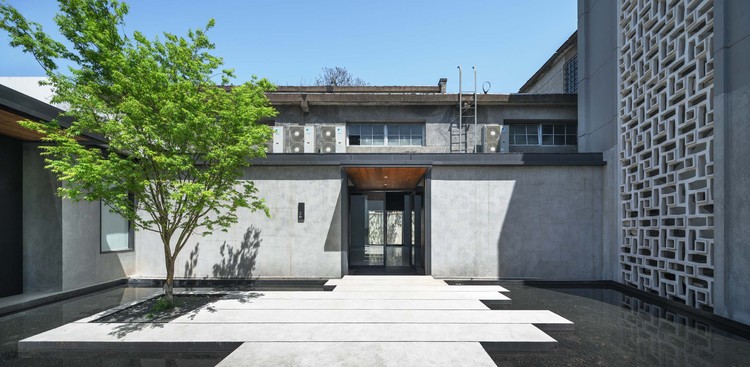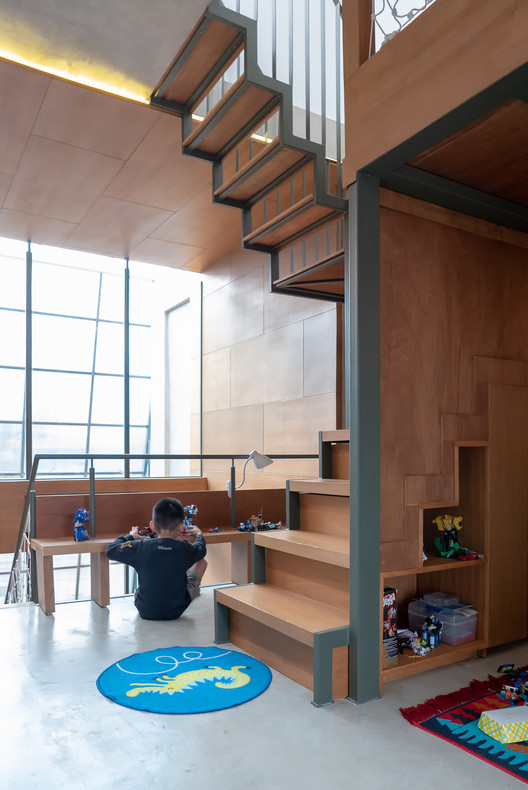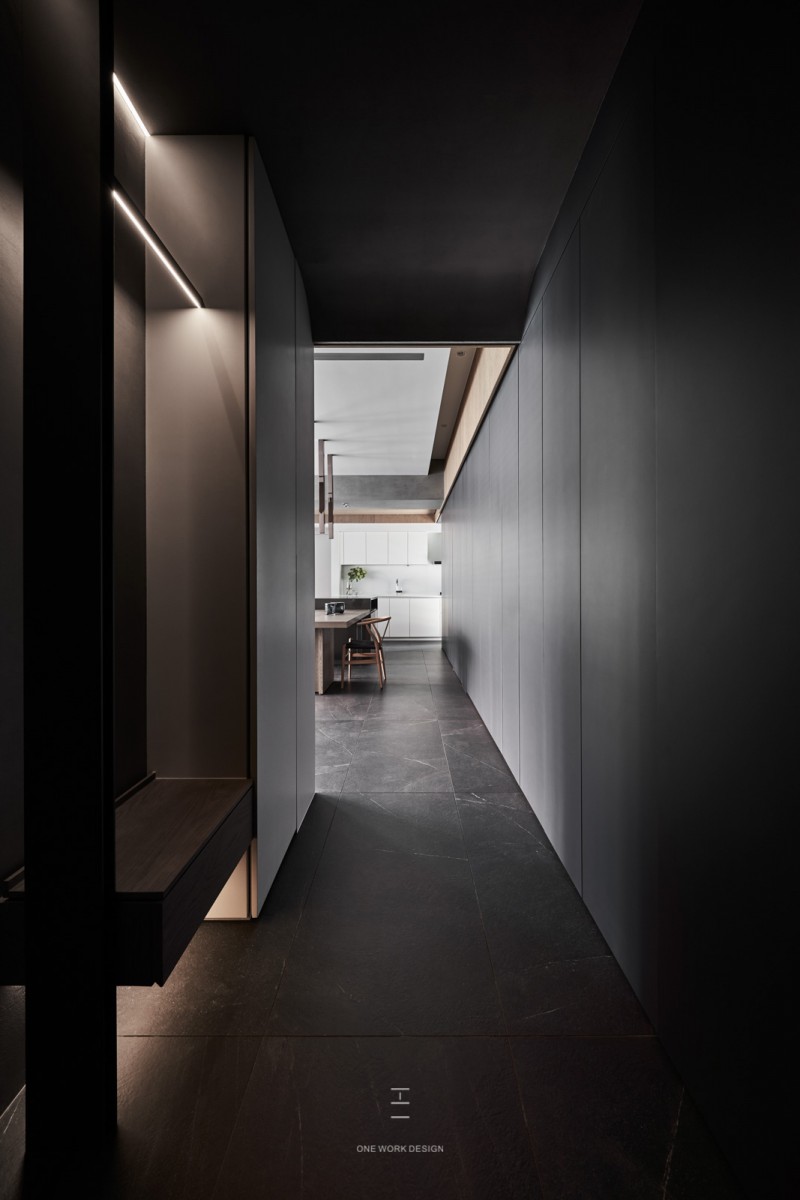Tongling Recluse RSAA Büro Ziyu Zhuang
2017-11-15 22:00
© SU Shengliang
(三)苏胜良


这个项目的主人吴彦祖说:“紫玉,看看我们村子里幸存下来的这棵最高的树。它很美。重建后应该在我们的房子里看到。“所以我们把这堵残墙分成两部分,中间的部分被用作庭院,晚上我们可以欣赏星星,四面八方的水可以流入其中。屋檐将两个山脊划分为平行于山的不同材料。高耸的幸存树和古老的村庄被纳入我们的铜陵隐士。-紫玉庄,山户回忆录
The owner of this project Daniel Wu said, “Ziyu, look at this tallest tree survived in our village. It is beautiful. It should be seen in our house after rebuilt.” So we divided this residual wall into two parts; the middle part was used as a courtyard where we can admire the stars at night and the water from four directions can flow into it. The eaves divided the two ridges in different materials parallel to the mountains. The towering surviving tree and old village were included into our Tongling Recluse. - Ziyu Zhuang, Memoir of Mountain Household
© SU Shengliang
(三)苏胜良




在中国今天的建筑实践中,传统和现代是交织在一起的,就像铜陵隐士一样。它位于安徽北部的一个偏僻的村庄,原本是徽州和延江风格的普通民居。这座坐落在山顶上的小房子被杂草和灌木丛覆盖着,十多年来一直无人居住;它在东西方向有三个海湾,在南北方向有一个海湾。它原来的屋顶和墙壁严重受损。
In today's architectural practice in China, tradition and modernity are interwoven and coexist together, just like this Tongling Recluse. It is located in a remote village in the north of Anhui Province originally a normal folk house in the style of Huizhou and Yanjiang. Nested on the top of the mountain, this small house was in an extremely bad condition covered by weeds and bushes and uninhabited for over ten years; It has three bays in east-west direction and one bay in south-north direction. Its original roofing and wall were badly damaged.
© SU Shengliang
(三)苏胜良


从平面布局出发,我们考虑向西加上一个海湾,到达一边的岩石山,另一个海湾在南北方向形成一个更广阔的居住空间;我们利用上升的横扫曲率,创造出一个与原始投影分离的想象空间。由于原有高度的限制和严重破坏的屋顶,我们在原有建筑中增加了两层以上的新楼层,加上与原投影分离的想象空间,我们创造了一个开放的空间视图。我们在前面降低了部分山脊,形成了凹凸不平的连续弯曲轮廓。传统的折顶和分离的流线型空间融合在一起,与中国文化的宇宙学相吻合-“道(道)生一(世界),一生二(阴阳).”;从鸟瞰的角度看,整个屋顶被灰色的瓷砖覆盖着,这不仅是突出的,而且也是现有古村的会合。这是第一次在室外地区反映室内空间的特点。
Starting from the plan layout, we considered adding one bay to the west to reach the rocky mountain on one side, and another bay in the south-north direction to form a wider living space; We used sweeping curvature that rises to create an imaginary space detached from the original projection. Because of the limitation of original height before and badly damaged roof, we added new floors to the original building up to two. Together with the imaginary space detached from the original projection, we create an open spatial view. We lowered part of ridge in the front to form an uneven continuous curved silhouette. Traditional folded roof and the detached streamlined space were blended together and coincided with the cosmology of Chinese culture - “The Dao (Way) produces One (world), One produces Two (Yin-Yang)....”; the whole roof was covered by grey tiles in an unique shape from a bird’s eye view, which was not only outstanding but also a convergence of existing ancient village. This was the first time to echo the features of indoor space in outdoor areas.




这四个海湾形成了一个东西方向的空间.从东到南,一个海湾被用作客厅旁边的前厅。如果残余墙是连接二楼玻璃平台的庭院,则有一个隔间横穿部分。一个海湾与原来的墙壁在西方形成了一个空间的卧室;增加的地板,西面覆盖山景和部分已建成的景观,进入其半开放的虚拟空间的屋檐下。俯瞰南面,这是传统语境下现代民居的画面。
The four bays formed a space in east-west direction. From the east, one bay to the south was used as the front hall next to the living room. One bay transversing part if the residual wall was a courtyard connecting the glass platform in the second floor. One bay with the original wall in the west formed a space for the bedroom; The added floor to the west covered the mountain view and part of the built landscape into its semi-open virtual space under the eaves. Elevation view looking south this is picture of modern house under traditional context.


东高地在单脊建筑的一侧形成了一条新的山脊,体现了双生子关系,形成了一种和平的平衡。新的山脊形成了自己的海湾。其中一半融入了原始建筑的室外轮廓,另一半则形成了屋檐下的阳台。该设计展示了东面立面实体房屋的虚拟空间,并与南方沉陷的园林景观进行了交流。与南方的分散景观不同,东部的高海拔悬崖投射出单体景观。它预示着房子内的铜装置和聚光灯的露台和屋檐的活力和期望。
East elevation generated a new ridge on the side of single ridged original building, manifesting the twin relationship and forming a kind of peaceful balance. The new ridge formed a bay of its own. One half of it incorporated into the outdoor contour of original building and another half formed the veranda under the eave. The design shows the virtual space against physical house in east elevation and converses with sunken garden landscape in the south. Different from the scattered view in the south, the high altitude cliff to the east projected a single-body view. It foretells the vitality and expectation of the copper fixtures inside the house and the spotlighting terrace and eaves.
© SU Shengliang
(三)苏胜良


© SU Shengliang
(三)苏胜良


主室内空间与外廊混合,形成交错的新旧墙。建筑物中原来受损的墙变成了室内墙和室内隔墙的一部分。从东到西,露台、客厅、餐厅、厨房、庭院和卧室都按照隐私排列。通过外廊和台阶,居民可以从南方来到客厅举行家庭聚会或活动,一楼的部分空间是空的,可以看到更好的景色,向右走到半开放的露台,居民可以俯瞰群山和整个村庄;从这里左转,居民可以到达餐厅与更好的隐私和厨房对面。一楼是一间卧室和休息室。从起居室上楼,有两间卧室和休息室。
The main indoor space mixed with the external veranda shaped by the interlaced new and old walls. The original damaged walls in the building became sections of interior walls and indoor partition. From the east to the west, terrace, living room, dining room, kitchen, courtyard and bedroom lined up according to their privacy. Through the veranda and steps outside, resident can come from the south into the living room to hold family parties or activities here. Part of the first floor was empty space for better view; Coming to the right to the semi-open terrace, resident can overlook the mountains and the whole village; From here turning left, resident can reach the dining room with better privacy and the kitchen opposite to it. On the first floor were a bedroom and rest room. Going upstairs from the living room, there were two bedrooms and rest rooms.
© SU Shengliang
(三)苏胜良


中庭作为整个规划布局的核心,由原来的室内空间向新的室外空间转变。原来的墙壁和南方的旧门被保留着,以表示对原始记忆的尊重。作为对比和回响,我们在旧门的一侧设置了一扇高1.5米,宽1.2米的黄铜制造的新门,以比例上的巨大差异来加强仪式的感觉(这种做法在欧洲许多现代教堂的空间设计中是常见的)。作为铜都背景的呼应,通过这扇铜门进入房间,有一个铜框架餐厅与之相连。我们安装了一个镀铜楼梯,通往二楼。这个铜火焰也把原来的山墙搬到了东方。原来这里的山墙成了装饰墙,挡住了客厅和卧室的垂直视野。在铜架的北面,有一间厨房,里面有一套完整的铜器具和北面的后门,在那里我们可以下楼到山下的菜地。整个厨房都嵌在墙上,从北边的山墙突出出来。我们把所有的室外空调和凸出山墙的铜框/厨房结合起来。从鸟瞰的角度,我们可以感受到整个建筑铜部分的空间联系,以及布局设计中材料的连续性。建筑的主要结构和其他部分是木质材料,这些材料再现了原建筑的生活条件和文化背景。
As the core of the whole plan layout, the atrium changed from the original indoor space to the new outdoor space. The original wall and old door in the south were kept to show the respect to the original memory. As a contrast and echo, we set a brass-made new door with the height of 1.5 meter and the width of 1.2 meter on one side of old door to strengthen the ceremonial feeling by huge difference in proportion (such practice is common in the spatial design of many modern churches in Europe). As an echo to the context of copper capital, coming into the room through this copper door, there is a copper-framed dining hall connected with it. We have installed a copper-plated staircase to reach the second floor. This copper flame also carried the original gable in the east. The original gable here became the decorative wall to block the vertical view of the living room and bedrooms. In the north of copper frame, there was a kitchen equipped with a full set of copper apparatus and the backdoor in the north, where we can go downstairs to the vegetable field under the mountain. The whole kitchen was inset to the wall and protruded out of the northern gable. We combine all the outdoor air conditioners and the copper frame/kitchen protruded out of the gable. From a bird's eye view, we can feel the spatial linkage of the copper sections of whole building and the continuity of materials in layout design. Main structure and other sections of the building were wooden material, which reproduced the living conditions and cultural context of the original building.
Ground Plan




整个中庭和屋檐下的景观在东西向形成了重复的虚拟物理转换。同时,东侧悬空的楼梯和法式窗户形成了连接传统民居中找不到的卧室的空旷空间。南北方向排列着一排高高的窗户,把两个倾斜的屋顶与墙壁隔开了。设计的目的是加强屋顶的漂浮性和现代性。另一组小窗户,加上重要的固定装置,包括楼梯和主卧室,形成了与室内和室外空间对比相呼应的视线。
The whole atrium and the landscape under the eave formed the repeating virtual-physical transformation in the east-west direction. At the same time, the suspended stairs and French window in the east formed an open space connecting the bedrooms which cannot be found in traditional folk residences. An array of high windows lined up in the north-south direction separated the two sloping roofs from the walls. The design was to strengthen the floating and modernity of roof. Another array of small windows together with important fixtures including stairs and master bedroom formed the line of sight that echoes the contrast between indoor and outdoor space.
© SU Shengliang
(三)苏胜良


© SU Shengliang
(三)苏胜良


在建筑物南面的入口处可以看到部分室外景观。软景观元素的目的是创造与建筑物的视觉画廊。与弯曲的屋顶相结合,偏远的山脉成为风景如画的一部分。西南方有一扇门。走上山,建筑物的景色被大门打断,形成了第一道风景。大门与北方的建筑一起形成了封闭的庭院,南面的墙很短,建筑和喀斯特石山以西的屋檐下的空间形成了环形的石阶露台,从大门入口到屋檐下的庭院;在东南,有一个凹陷的庭院,把原来高大的乔木树结合在一起,强调有限的空间,作为户外休息的地方,有石桌和石椅。由于东侧的悬崖不陡,建筑的装饰元素凸出高达2米。在自然的台阶和植物的引领下,居民可以通过建筑北侧的后门到户外露台和绿地,远离世俗的关怀,享受乡村风景如画。
Part of the outdoor landscape can be viewed at entrance in the south of the building. Soft landscape element was aimed at creating the visual gallery with the buildings. Combining with the curved roof, remote mountains became part of the picturesque scene. A gate lies in the southwest. Walking up the mountains, the view of the building interrupted by the gate formed the first scenery. The gate also formed an enclosed courtyard together with the building in the north , and short walls in the south; The space under the eave to the west of buildings and karst rocky mountain formed an annular stone steps veranda, starting from the entrance of gate to the courtyard under the eave; In the southeast, there was a sunken courtyard t combining the original tall arbor tree to emphasize the limited space, which was used as an outdoor resting place with stone table and stone chair. Because of the cliff on the east side was not steep, decoration element of the building protruded s up to 2 meters. Led by the natural steps and plants, resident can go to the outdoor terrace and green area through the backdoor on the north side of the building, away from the worldly cares and enjoy the countryside and rural picturesque .
© SU Shengliang
(三)苏胜良


在场地条件的限制下,为了快速实现屋面的三维曲率,减轻结构框架尺寸的影响,保留基本的传统建筑元素和构件,我们在现场采用钢框架对整个建筑进行了改造,并在现场安装了一座连接工地与相邻道路的悬挂式栈桥,用于建筑材料的运输。
Under the limitation of site condition, in order to quickly realize three-dimensional curvature for the roof and weaken the impact of the size of structural frame to retain essential traditional architectural element and component, we used steel frame and rebuilt the whole building at the site. A suspended trestle was mounted connecting the site to adjacent road for the transport of construction materials.
© SU Shengliang
(三)苏胜良


© SU Shengliang
(三)苏胜良


为了在有限的技术条件下建造两个弯曲的屋顶,我们把与山体平行的墙“切”成若干条折线,从山脊方向的几条结构曲线开始,建筑物的所有表面都被一个钢网覆盖。沿山脊的构造线的尺寸扩大,进一步显示了双面屋顶。在该结构体系中,利用表面像素木条工艺,可以巧妙地调整和优化屋顶曲面的角度和位置。
To build a two curved roofs in limited technical conditions, we "sliced" the wall in parallel to the mountain into a number of broken lines and started from the several structural curves in the direction of ridge. All the surfaces of the building were covered by a steel grid. The size of structural line along the ridge was enlarged to further indicate the twin roofs. In this structural system, the angles and positions of the curved surface of the roofs can be subtly adjusted and optimized in three dimensions using pixel wood batten craft on the sur
© SU Shengliang
(三)苏胜良


根据钢结构的结构形式,在施工过程中对原墙的旧砖进行了编号标记,并将其存放在一边。在新基础和主钢结构建成后,用标记的旧砖在现场重建原墙。在墙体改造过程中,许多旧砖块被切成薄片,作为传统装饰,隐藏在钢结构的内部。(这种方法在回收和重建传统房屋的过程中,为了节省旧砖块的材料)用不同类型的旧砖块从当地其他建筑中建造新墙。为了进一步突显这一差异,我们在新的墙壁上铺上了长江下游南部和惠州常见的白色油漆,在两种砖的交界处进行了处理,恢复了旧的和谐统一。利用从其他老建筑中收集的旧材料和旧瓷砖,利用当地的传统技术,由当地工匠建造整栋建筑的柱子和屋顶,从而对本土文化和乡土可持续观念作出回应。
Based on the structural form of steel structure, during construction the old bricks of the original wall were marked down with numbers and kept aside. After the new foundation and main steel structure had been completed, the marked old bricks were used to rebuild the original wall at the site. In the process of rebuilding the wall, many old bricks were cut into slices and used as traditional decoration for hiding the steel structure inside. (This method is common in order to save the materials of old bricks in the process of recovering and rebuilding the traditional houses) New wall was built by different types of old bricks from other local buildings. For further underlining the difference, we laid white paint which is common in the south of the lower reaches of the Yangtze River and Huizhou on new walls. At the junction of two kinds of bricks we did some treatment and restored as old for harmony and unification. Using old materials and old tiles collected from other old buildings, the columns and roof of the whole building were built by local craftsmen with local traditional techniques, In this way, we responded to the native culture and the vernacular sustainable concept.
© SU Shengliang
(三)苏胜良
























































































































Architects RSAA
Location Tongling, China
Architect in Charge Ziyu Zhuang
Design Team Zhengdong Qi, Jing Li, Xin Zhao, Hongyu Fan, Kunyu Zhu, Jiaxin Wang (Intern)
Area 160.0 m2
Project Year 2017
Photographs FNJI, Ting Xu
Category Refurbishment
























